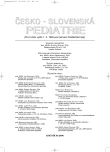-
Medical journals
- Career
Possibilities of Endoscopic Techniques in Neurosurgery in Solving Hydrocephalus – First Experience with the Use of Laparoscopy
Authors: L. Zeman; M. Tichý *; D. Hořínek *; M. Rygl; M. Vaculík *; M. Vyhnánek
Authors‘ workplace: Klinika dětské chirurgie 2. LF UK a FN Motol, subkatedra dětské chirurgie IPVZ, Praha ; Oddělení dětské neurochirurgie FN Motol, Praha *
Published in: Čes-slov Pediat 2006; 61 (6): 365-369.
Category: Original Papers
Overview
Objective:
The communication deals with the application of endoscopic techniques in the treatment of hydrocephalus. Endoscopy can be used in intracranial introduction of catheter and in placing the distal catheter in abdominal cavity. From the abdominal cavity laparoscopy enables to remove a dislocated distal catheter or to disintegrate the adhesions or pseudocysts. The communication describes our first experience with the used of laparoscopy in surgical treatment of hydrocephalus.Material and methods:
The group included patients, where clinical findings indicated modified anatomical conditions in abdominal cavity. The patients were purposely examined by standard imaging methods (computed tomography, magnetic resonance and sonography). The laparoscopic operations were performed in general anesthesia with the application of laparoscopic instruments of the 3–5 mm diameter (Olympus). The port for camcorder is localized under the umbilicus and the further working port is localized according to pathological-anatomical conditions under visual control. The intervention is performed by a children surgeon. In the intracranial localization (in arachnoidal cysts, septations, asymmetric chambers or narrow chamber system) a narrow neuroendoscope is introduced from a frontally localized drill hole, which enables a precise control of introduction of the proximal catheter. The intervention is performed by a neurosurgeon.Results:
In the years 2003–2005 four patients were operated on by laparoscopy. In three cases the dislocated catheter was removed and in the fourth patient the old catheter was replaced by a new distal catheter. The interventions were made without complications and the shunts were functional.Conclusion:
The first experience indicate that in indicated cases laparoscopy may contribute in a difficult or risky introduction of distal catheter or in solving intra-abdominal complications associated with ventriculo-peritoneal drainage.Key words:
hydrocephalus, laparoscopy, endoscopy
Labels
Neonatology Paediatrics General practitioner for children and adolescents
Article was published inCzech-Slovak Pediatrics

2006 Issue 6-
All articles in this issue
- Is the Prenatal Origin of Acute Myeloid Leukaemia Common?
- Amanita Phalloides Intoxication – Fully Treatable Event. 25-year’s Experience in Children
- Certain Aspects of Family Environment of Czech Children. Results of the ELSPAC Study
- Possibilities of Endoscopic Techniques in Neurosurgery in Solving Hydrocephalus – First Experience with the Use of Laparoscopy
- Hereditary Fructose Intolerance
- Perspective in the Prevention of Childhood Injuries in the Czech Republic
- Guidelines on the Diagnostics, Treatment and Prevention of Infectious Endocarditis in Children. Working Group of Pediatric Cardiology, Czech Society of Cardiology and Czech Society of Pediatrics
- Czech-Slovak Pediatrics
- Journal archive
- Current issue
- Online only
- About the journal
Most read in this issue- Guidelines on the Diagnostics, Treatment and Prevention of Infectious Endocarditis in Children. Working Group of Pediatric Cardiology, Czech Society of Cardiology and Czech Society of Pediatrics
- Amanita Phalloides Intoxication – Fully Treatable Event. 25-year’s Experience in Children
- Hereditary Fructose Intolerance
- Is the Prenatal Origin of Acute Myeloid Leukaemia Common?
Login#ADS_BOTTOM_SCRIPTS#Forgotten passwordEnter the email address that you registered with. We will send you instructions on how to set a new password.
- Career

